From The CRPG Addict
 |
| A minotaur takes apart my party while I hit him occasionally for 2 hit points. |
Aside from its graphics and sound, which I began my first entry by praising, Ishar feels like a “lite” version of every game that inspired it. It’s like it took a bunch of other RPGs but only copied their most superficial features. It has the character attributes, skills, and leveling of a lot of RPGs, but not with any depth or complexity. It has the switches and keys of a game like Dungeon Master but none of the challenging puzzles. It has a combat system that looks something like Might and Magic III or Eye of the Beholder, but it doesn’t really get it right. It’s like a movie with great cinematography but bad acting and not much of a plot.
I don’t know how to judge its combat system. Either the developers screwed up or they deliberately did something different but in doing so introduced new problems. On the surface, it adopts a Dungeon Master convention of giving each character an attack button and having them trade attacks with enemies in real time. It even does one better by mapping the attacks to the function keys. The problem is that there’s no cool-down, so it hardly makes sense to have all your characters attack. In fact, it makes the most sense to have the character with the best combat skills attack exclusively, keeping the others up front only as meat shields, to spread out the damage taken from enemies. The attacking character has to eat more often to regain stamina, but otherwise there’s no downside.
I’m not sure I understand the little combat formation grid that you can activate on the right side of the screen. Each character has a unique symbol, and you can arrange those symbols on a 5 x 5 grid to make ranks and formations. It’s not a bad idea, but I don’t think the game really makes full use of it. Characters not in the front rank can neither hit nor get hit in melee combat, but beyond that, I don’t see where the specific position and arrangement matter. Someone correct me if you know more.
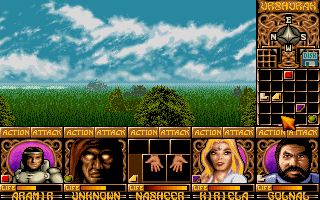 |
| This arrangement doesn’t seem to do anything different than putting one character anywhere in the front rank and the other characters anywhere in the other four ranks. |
The worst part about combat is how the game treats missile weapons and spells. If a character is equipped by a missile weapon, hitting the attack key doesn’t launch it; it brings up a cursor so that you can click on the specific enemy that you want to target. Why is this extra step necessary? Melee weapons don’t target specific enemies. If combat paused while you made your selection, that would be one thing, but instead enemies continue to attack while you take your hand off the keyboard and move it to the mouse to point at a specific enemy and click.
Spells are even worse. To cast one, even in combat, you have to click the “Action” button, then “Cast Spell,” then the name of the spell, and then target it, all while enemies are pounding away.
 |
| Casting takes too much time to do in combat. |
Both missile weapons and spells are a god-send, however, when you encounter the occasional enemy who refuses to advance. I wasted a lot of hours trying to melee a minotaur guarding a bridge with a morningstar in each hand. After several full-party deaths, I realized I could stand a square away and pelt him with arrows (albeit expensive ones), “Magic Missile” spells, and daggers until he finally collapsed.
A lot of spells are defensive or healing spells, and party members are useful for their other skills, including “Lockpicking,” “First Aid,” and “Languages.” But you need far fewer than the four companions you can choose to go on the adventure.
As for the innovations with NPC interactions, they’ve mostly been annoying. The one time I tried to kick an NPC out of my party, the other characters voted to overrule me and keep him. Meanwhile, NPCs that I want to retain have a way of disappearing in the middle of the night, with all the expensive stuff I’ve bought for them, when we stay at inns.
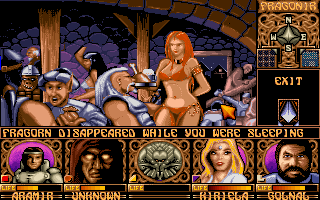 |
| Coward. |
I broke off the last entry by suggesting that I was going to try to map the island, which I estimated at 100 x 400 and concluded was “big but not unmappable.” That’s the problem with doing multiplication in your head. I had calculated it at 4,000 squares, which is the same size as a dungeon of 10 levels of 20 x 20. In fact, 100 x 400 is actually equal to 40,000–not Fate: Gates of Dawn, but still a few too many to map unless you really love the experience.
Upon studying the map in more detail, I realized that a map might be superfluous anyway. Kendoria is a large place–much longer east-west than north-south–but it’s mostly made up of small islands interconnected by bridges. It doesn’t take a lot of effort to comprehensively explore an island. You just run around its perimeter and crisscross the interior a few times.
 |
| Kendoria is less a “land” than an archipelago. |
The game begins on the furthest-west island, which is divided into Fragonir to the north and Angarahn to the south. Fragonir had the village on the docks, while Angarahn had the other village I explored last time. Between the two of them, they have a strength trainer and an agility trainer, but I still haven’t felt flush enough to use them. Angarahn has some encounters with orcs that seem to respawn. Enemies typically leave bags of a few hundred gold when they die, but it costs about 1,500 gold pieces to have a meal and a night’s sleep at a tavern.
East across the bridge from Angarahn is a large island with Lotharia on the west and Fimnuirh to the east. Lotharia has a small village to its north with a spell trainer. There were several encounters with werewolves or maybe bears, probably bears because later I fought somethings that looked more like werewolves. Fimnuirh is a huge, empty area where I keep getting attacked by something that I can’t see. I suspect that this is the “invisible lizard man” named Brozl that I learned about in an NPC’s hut. The NPC told me that to kill him, I would need to use a Mental Vision Helmet, wherever that comes from. I’ll need to kill Brozl because he has some magic rings that “protect from the dragon’s fire.”
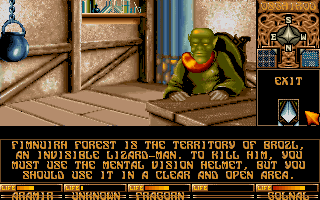 |
| I have no idea what race this NPC is. |
There was an interesting encounter in Lotharia with a floating head calling himself “Azalghorm the Spirit,” the messenger of the “Silmarilian Gods.” He told me that we “could attempt” three quests, all of which would help us “when you finally have to face [the] evil Krogh.” He said the quests were called “The Magician’s Talisman,” “The Exhausted Witch,” and gaining possession of all of the rune tablets. I have no bead on the first two quests, but I found one rune tablet on a pedestal in Lotharia and the other on a pedestal in the dungeon.
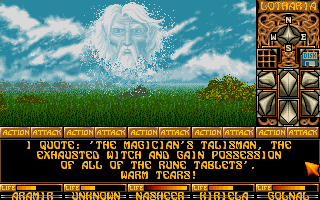 |
| The main quest turns into sub-quests. |
East from Fragonir and north from Lotharia is a small area called Osthirod. There were some encounters with tall, powerful werewolves plus a hut where a “medium” offered to give me medical advice for 1,000 gold pieces. I took a screenshot of some kind of tall sentinel in armor blocking access to some part of the area, but I neglected to mark where it was.
Most of my NPC companions were killed by the bears and werewolves, plus some bandits that I met in Osthirod’s neighboring nation of Rhudgast. I replaced them with a weird monk named “Unknown,” a warrior named Fragorn, and a priest named Kiriela, who I found standing around the wilderness of Fragonir. Soon afterwards, Fragorn disappeared when we stayed at a tavern for the night, so I replaced him with a terribly effective “spy” named Nasheer. Unknown is kind of useless except for his “Magic Missile” spell and Kiriela is useless except for her “Healing I” spell. Golnal is just useless, but the party wouldn’t let me kick him out. Aramir remains the best melee fighter.
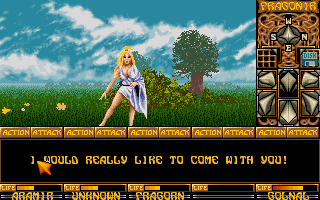 |
| Who’s your god? Hugh Hefner? |
Osthirod and Rhudgast occupy the same island, separated by a large, impenetrable thatch of forest. You have to cross between them on a small strip of land to the south. A pathway leads north from this strip of land to a dungeon entrance–the first in the game. There wasn’t much of a transition as I entered the dungeon, and it was small enough that I suspect it exists on the same scale as the outdoor map and could be mapped on the same piece of paper with it.
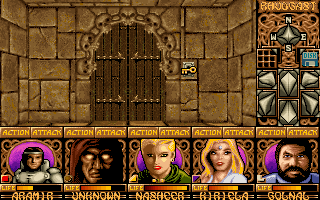 |
| The dungeon had some keys and levers but no puzzles. |
The dungeon was small and to-the-point. There were some doors I had to find keys to open and some barriers I had to lower with a lever. Monsters included skeletons, giant spiders, and some behemoth that took a couple of reloads.
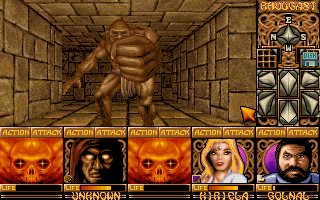 |
| The photographer didn’t make it. |
The rewards for the dungeon were a few treasure chests, an empty flask, and a rune tablet.
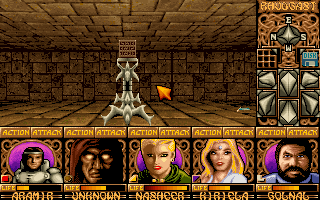 |
| Primitive cultures. They’re always placing rune tablets on a pedestal. |
All geography ultimately funnels to the land of Aragarth, on the far eastern side of the Osthirod/Rhudgast island. A bridge leads from Aragarth to what is essentially the second half of the game, and this is where I got bottlenecked for a time by a minotaur, until I learned how to kill him from a distance. On the other side of this bridge, I found the land of Silmartil, a much less hospitable place than the western lands. After I died at the hands of some barbarians, I decided I’d better do another loop around the lands I’d already explored and grind a bit.
I mostly need to start spending some money. I’ve been very stingy. My characters would probably do better with some more armor (so far, I’ve only found leather), helms, and shields, and everyone could train a few points in strength or agility perhaps. I need to stockpile more rations to restore Aramir’s stamina, since every attack reduces it by 1%. If the dungeon respawns, that might be an easy way to earn both experience and wealth.
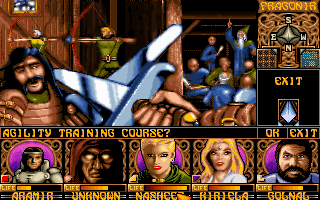 |
| This is probably the key to character development. |
Aramir is Level 6 now, everyone else either 3 or 4. I guess leveling affects maximum health and stamina, but as far as I can tell, skills are fixed from the beginning. (Unless they increase when you pay for attribute increases.) I’d probably do well to try to find better party members, but then again maybe I should be grateful that I have four of them who seem to get along and don’t bail on me at night.
To recap, Ishar is a pleasant enough game, but one that doesn’t grip me with its mechanics or its story. At least it’s pretty to look at.
Time so far: 6 hours
Original URL: http://crpgaddict.blogspot.com/2020/03/ishar-trophy-rpg.html
